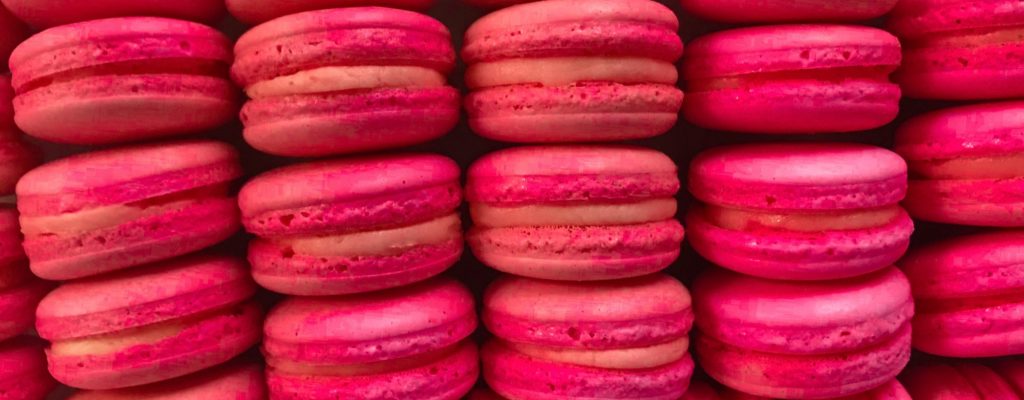Best Food Coloring for Macarons
Macaron batter is very delicate and can be affected by many small things. The best way to color your macarons is to use high-quality edible gel food coloring. Powdered food coloring can also be used, but it is not good for macaron batter. Water-based food colors are risky and you should know some tips before using them.
Let’s explore the art of coloring macarons together!
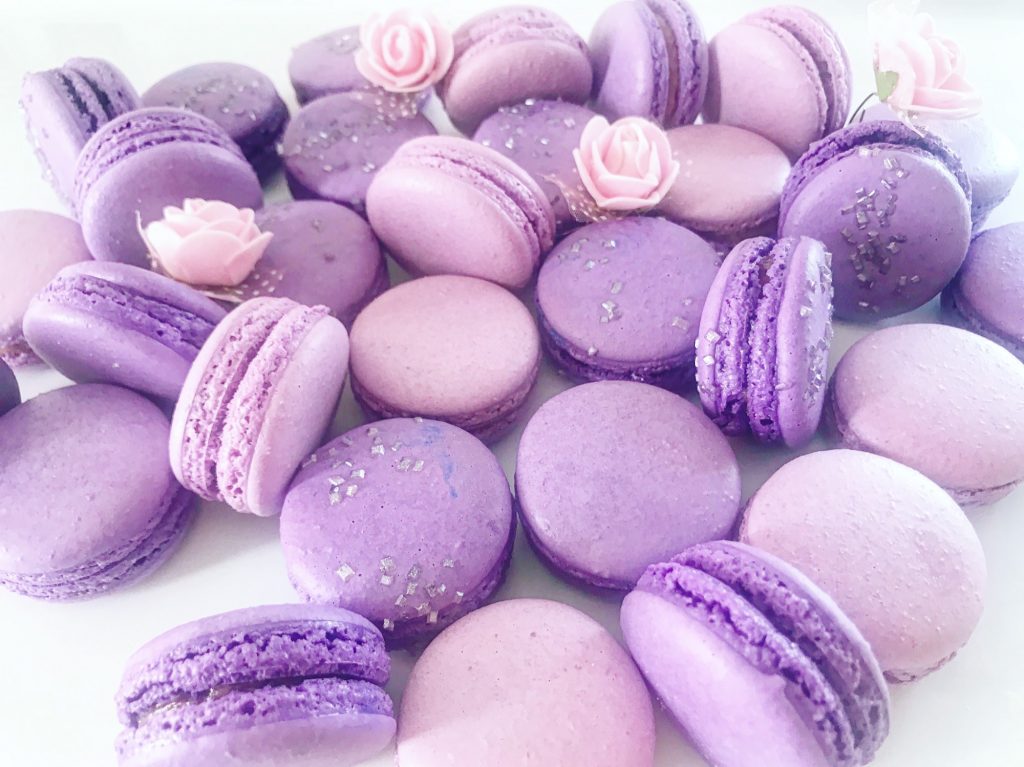
Food coloring recommendations
Navigating the variety of food coloring options on the market can be overwhelming. So, which brands deliver the most beautiful and vibrant colors for your macarons? Here’s a list of my favorite food coloring choices that consistently give stunning results.
The Best Gel-Based Food Coloring
The Best Powder Food Coloring
As an Amazon Associate, I earn from qualifying purchases.

Gel-based food coloring for macarons
Gel food coloring is the best choice for the macaron batter as it won’t ruin the batter’s consistency. You only need a tiny bit of it – I recommend using a toothpick to add it to the batter. As it is gel-based and you don’t need it in large quantities, it won’t change the consistency of the batter.
Good quality gel-based food colorings are highly concentrated so you only need a little drop of it to make your macarons colorful. Who wants to eat a lot of food coloring anyway?

Powdered food coloring for macarons
Yes, you can use powdered food coloring in your macaron batter. Powdered food coloring is a good choice when you want to get light pastel-colored macarons.
Powdered food coloring is usually not as concentrated as gel-based colorings so you need a lot more powder to get some color. The good thing is the powder won’t ruin the macaron batter so you have one less thing to worry about while baking macarons!
Additionally, powdered food coloring presents another way to beautify your macarons. After baking, simply dust the powdered color directly onto the macaron shells. With various edible powdered luster dusts to choose from, you can effortlessly enhance the look of your macarons, giving them an extra sparkle and charm.
TIP: I have written a comprehensive guide on how to use edible luster dust on macarons making them look extra fabulous. For example, colorful powdered dust is great to paint cheeks to your unicorn-shaped macarons.
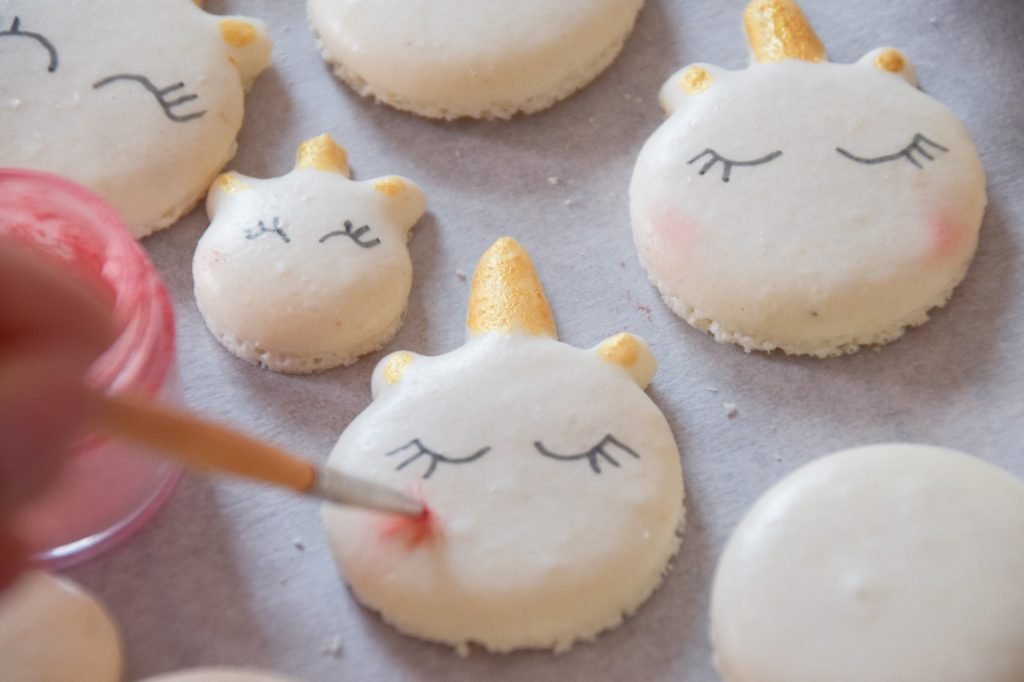
Liquid food coloring for macarons
Given the delicacy of macaron batter, it’s essential to be cautious with your choice of coloring. Even seemingly minor factors like humid weather can impact the quality of your macarons. Liquid food coloring, with its water-like consistency, poses a risk as it can interfere with the egg whites, resulting in a runny consistency. This can lead to macarons turning out hollow, lopsided, or cracked – certainly not the outcome you’re aiming for.
Despite the general recommendation against using liquid food coloring for macarons, there are still two viable methods for incorporating it. Firstly, when employing the Italian Method for baking macarons, you can add liquid food coloring into the sugar syrup. By heating the syrup, any excess liquid evaporates, ensuring it won’t affect the batter’s consistency. This is the only way to use it for macarons batter.
And secondly, you can also add a little liquid food coloring to the macaron fillings. This way, you can give the fillings a hint of color without worrying about messing up the consistency of the batter. Adding color to the filling still makes your macarons look vibrant.
How to get white macarons
If you’re aiming for pure white macarons, achieving that perfect shade can sometimes be tricky. Here’s a handy tip: adding a tiny amount of purple food coloring to your batter can help neutralize any yellowish tones, resulting in a beautifully pure white hue.
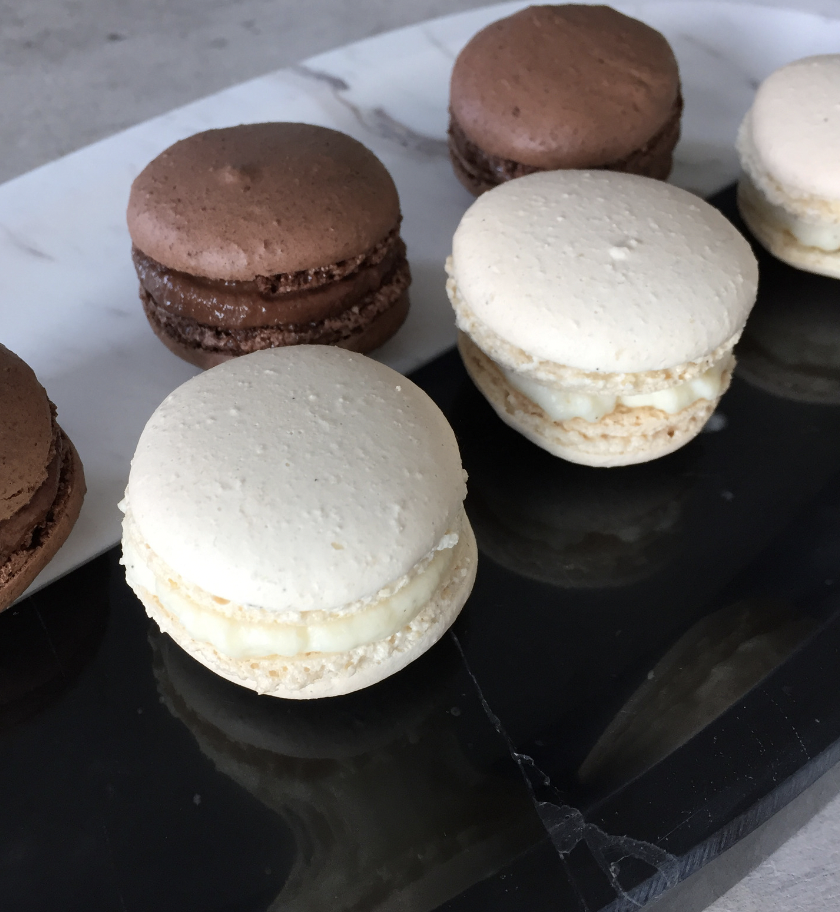
Here’s how to do it:
Firstly, add an extremely small amount of purple food coloring to the batter. Remember, a little goes a long way – only a tiny bit is needed to counteract any yellow tones.
Gently mix the food coloring into the batter until even and pipe your macarons as usual.
Next, halfway through baking, gently cover your macarons with a piece of foil. This helps shield them from excessive heat, preventing browning while ensuring they cook evenlyprepare your macaron batter as usual.
By incorporating these simple tricks, along with covering your macarons with foil halfway through baking, you can ensure your macarons come out with a flawless white color, ready to dazzle your taste buds and impress your friends and family.
How to get black macarons?
In the world of baking, making black macarons is like unlocking a secret recipe. It’s not as easy as just adding a drop of color – it takes a bit of skill and the right techniques.
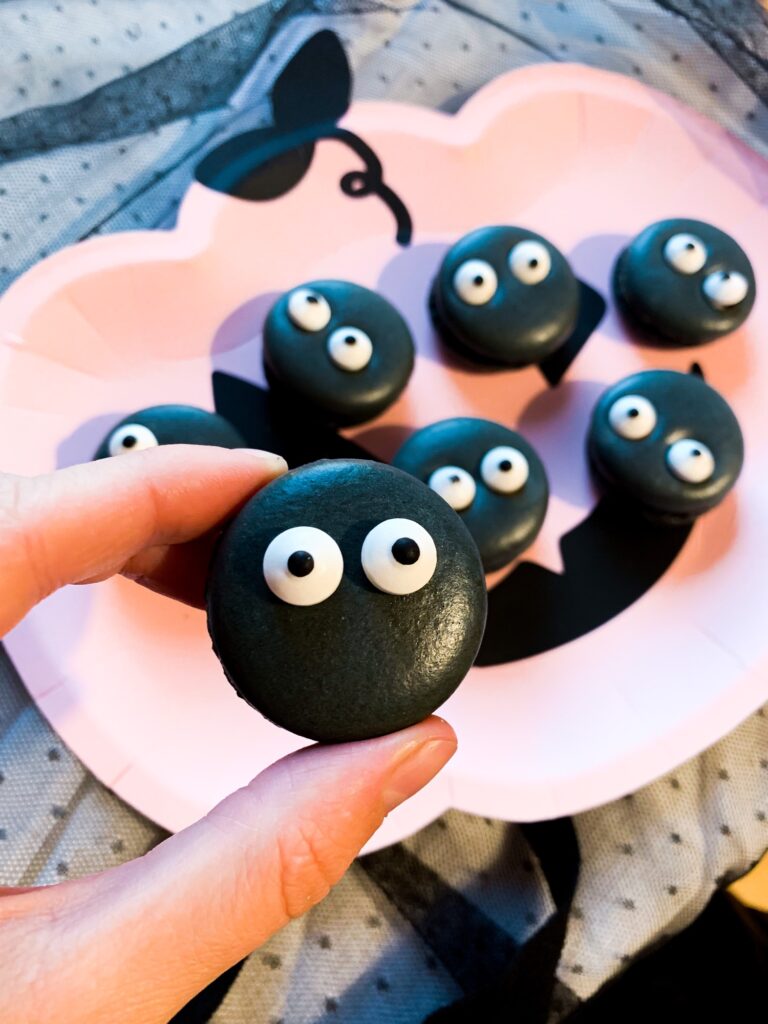
The most important thing is to get the right colors – black macarons need a lot of food coloring. Using just a little won’t make them black enough. You’ll need both gel and powder food coloring to get that deep black color. Using too much gel can mess up your macarons’ bottoms, and only using powder won’t give you that intense black. So, it’s best to mix both gel and powder for the perfect color.
If you only have gel food coloring, don’t worry. You can still make black macarons using the Italian method. This means adding one part of the gel color to the sugar syrup. It helps get rid of extra liquid, so your batter stays perfect.
Practice Makes Perfect: If you’re new to baking, it’s a good idea to practice making basic macarons first. Get comfortable with the batter and how it works. Then, you can tackle black macarons with confidence. Baking is all about having fun and trying new things. Don’t worry if your first batch isn’t perfect – that’s part of learning! Keep experimenting, and you’ll soon master the art of making black macarons.
How to obtain a vibrant macaron shell color?
Achieving vibrant colors on your macaron shells is an art, and it starts with the right choice of food coloring. Opt for gel food coloring made from synthetic colors rather than natural ones, as they offer more intense and consistent hues.
Next, don’t be afraid to use a generous amount of food coloring to achieve the desired vibrancy. For instance, when creating vibrant red macarons for Valentine’s Day, I often find myself adding more than two teaspoons of food coloring to achieve the perfect shade.
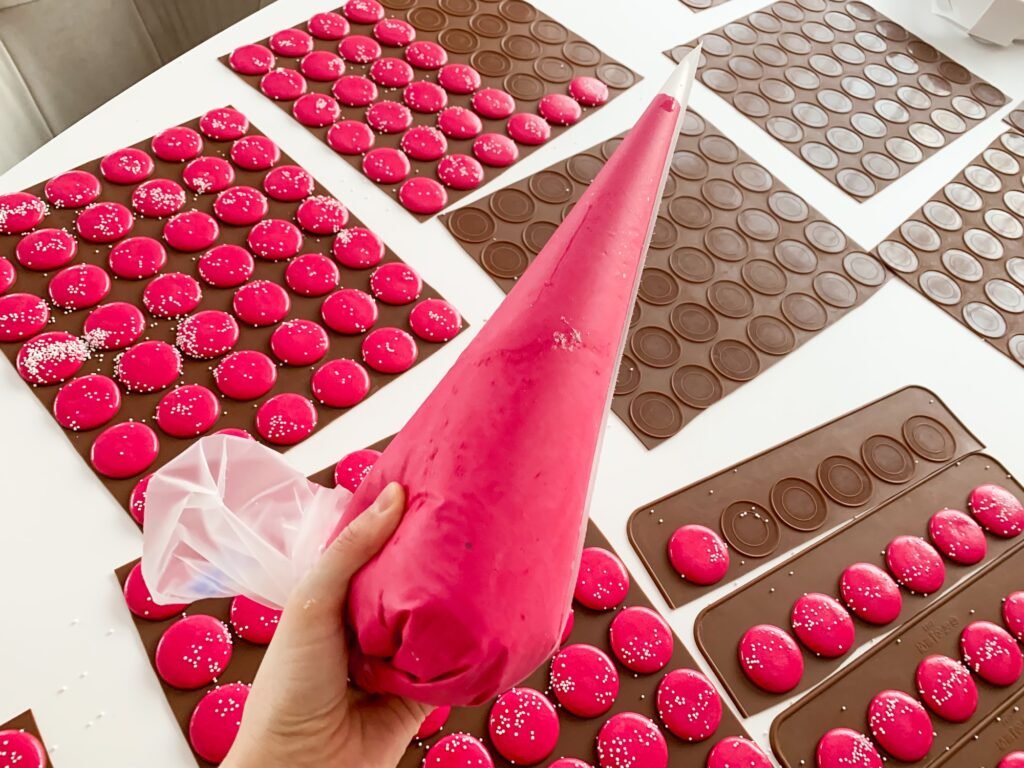
However, if you’re aiming for exceptionally vivid colored macarons, consider using the Italian Method for baking your macarons. Italian method involves incorporating boiling sugar syrup into the batter. In this case, instead of adding all the gel food coloring directly to the batter, you can add half of it to the sugar syrup just before boiling. This allows the excess liquid from the gel food coloring to steam away, minimizing its impact on the batter’s consistency and ensuring your macarons maintain their desired texture.
In essence, the formula for vibrant macaron shell colors is simple: use plenty of the right kind of gel food coloring and, if needed, utilize the Italian macaron baking method for optimal results. With these tips, you’ll be well on your way to creating visually stunning macarons that are as vibrant as they are delicious.
Can beginners add food coloring to their macarons?
Many macaron instructors caution new bakers against incorporating food coloring into their macaron batter. The reasoning behind this advice is simple: as a beginner, it’s essential to familiarize yourself with the batter’s ideal consistency and texture before introducing additional elements.
Adding food coloring can significantly alter the batter’s consistency, making it more challenging to gauge its readiness and potentially leading to undesirable outcomes. However, with more experience under your belt, you’ll become better at navigating these changes and adjusting your technique accordingly.

Furthermore, it’s common for beginners to get carried away with adding food coloring. In their eagerness to achieve the desired color, they may continuously add more coloring and stir the batter excessively. This over-mixing can detrimentally affect the batter’s structure, resulting in macarons that don’t achieve the desired texture or appearance.
In summary, while it’s best for beginners to focus on mastering the fundamentals of macaron-making before experimenting with food coloring, with practice and experience, you’ll gain the confidence and skill to incorporate coloring effectively and achieve stunning results.
Enjoy your macarons!
Belli xx
